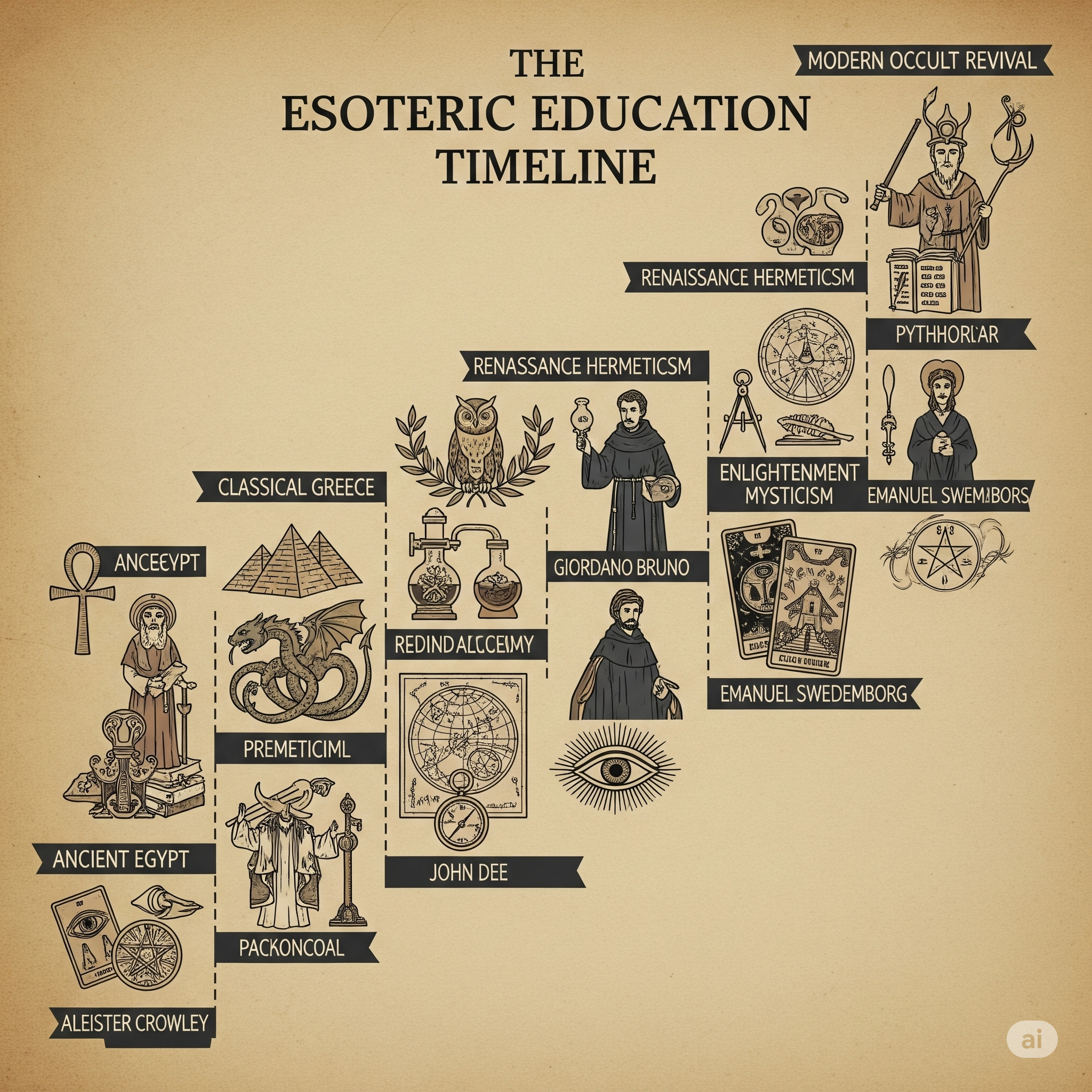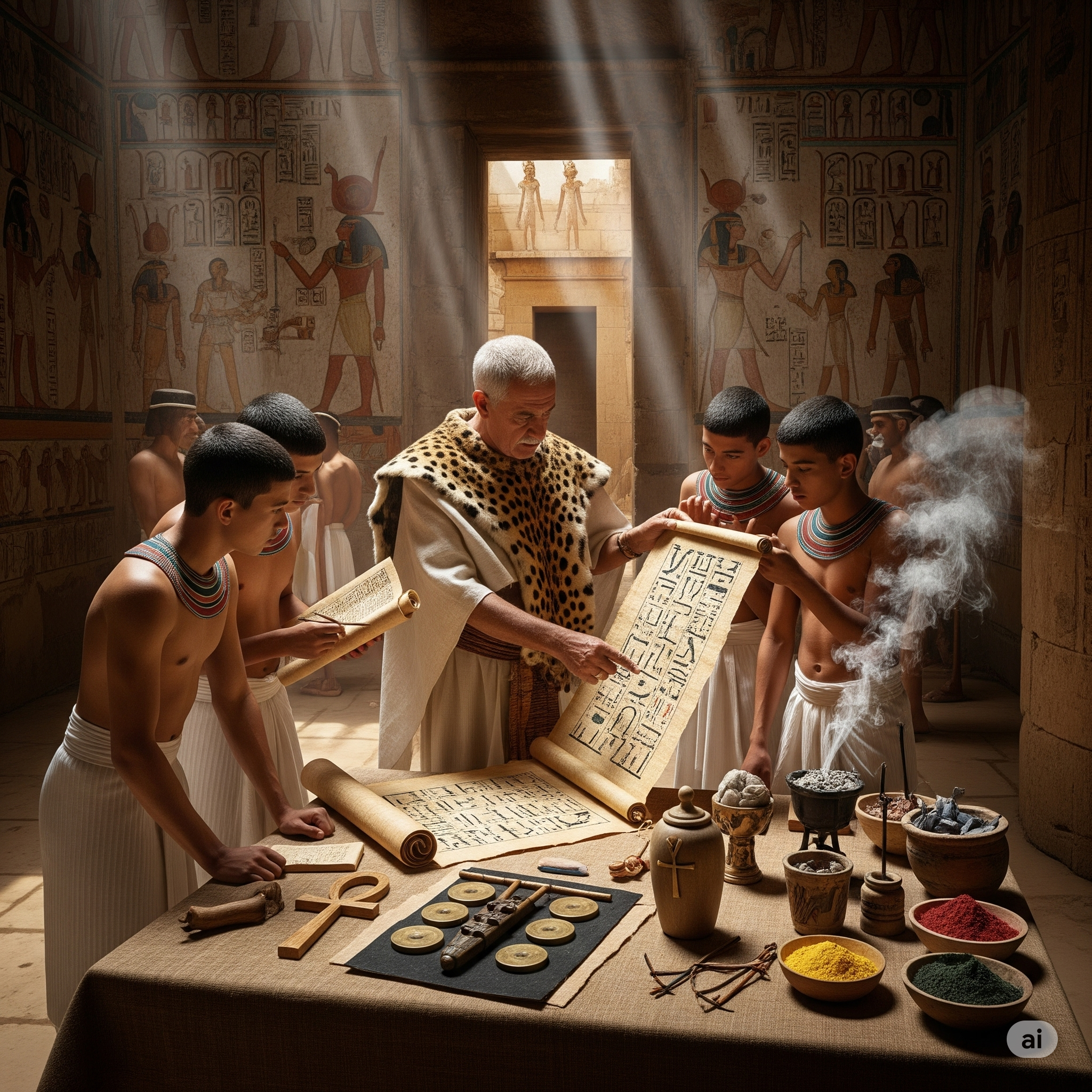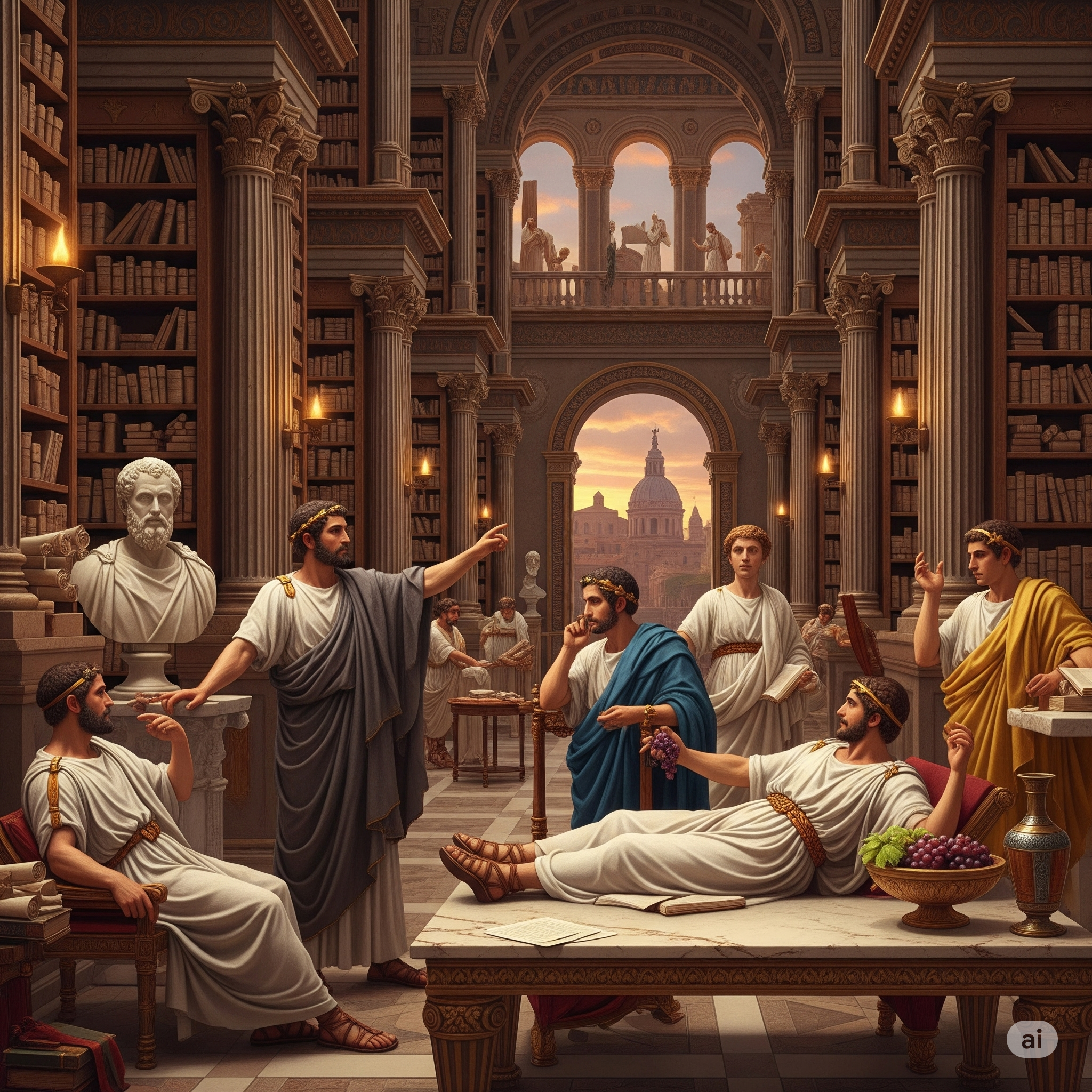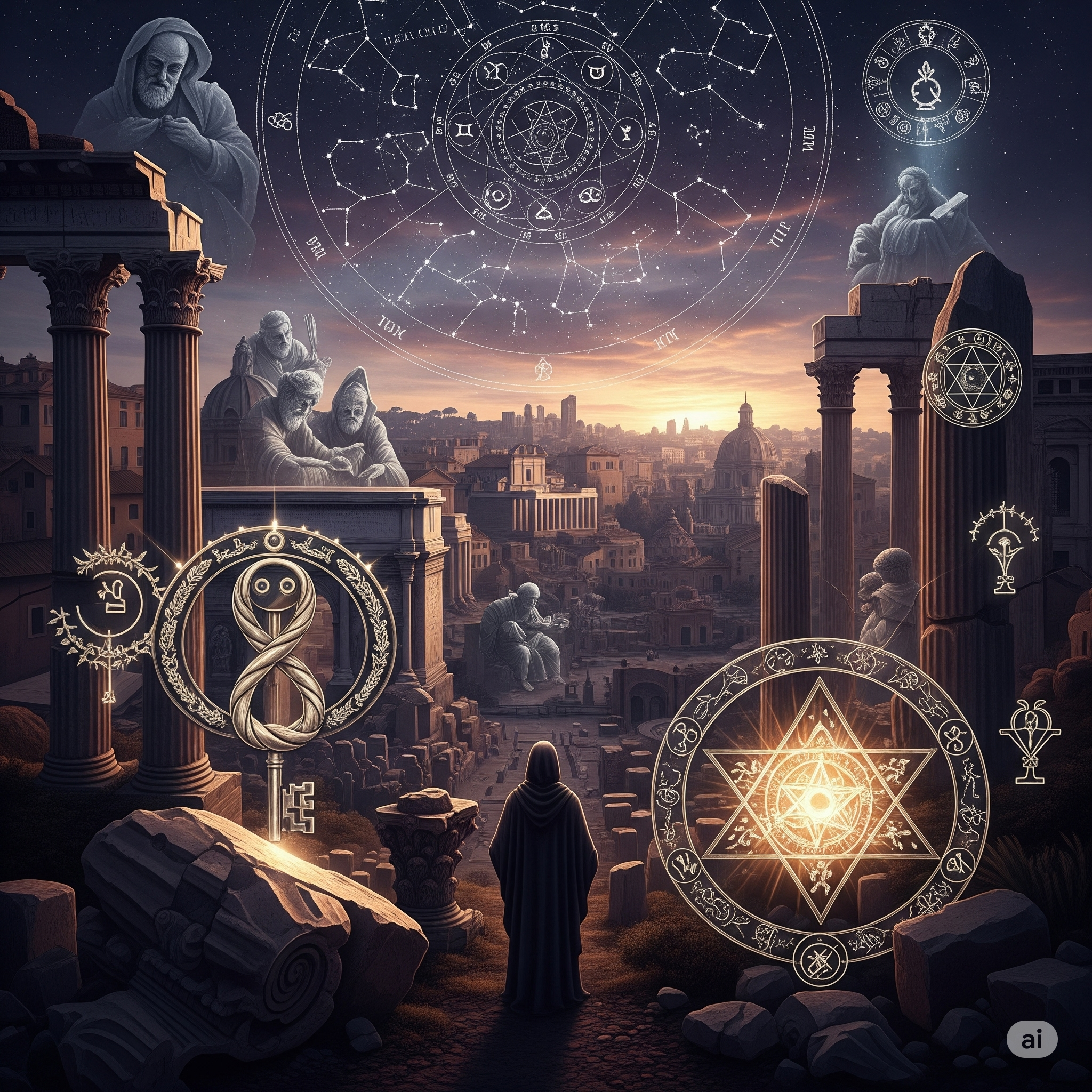Leola Bellamy
Study With Artemis, Inc
Copyright 2025
Introduction to Esoteric Business Models (Learning Pathway)
Leola Bellamy
August 3, 2025
Beginning Esoteric Business Models Study
Today I want to begin my personal study of Introduction to Esoteric Business Models and begin to document the research on my other portfolio page in greater detail.
Leola Bellamy
August 3, 2025
Esoteric Education Timeline Visual
Here’s a visual representation of the Esoteric Education Timeline.

Leola Bellamy
August 4, 2025
Roman vs. Egyptian Esoteric Education
Leola Bellamy
August 4, 2025
Egyptian Esoteric Education and the Afterlife
- Ethical Conduct (Ma’at): The concept of Ma’at, representing truth, justice, and cosmic order, was central. Living in accordance with Ma’at was believed to ensure a favorable judgment in the Hall of Two Truths, where one’s heart was weighed against the feather of Ma’at. This encouraged honesty, fairness, and respect in daily interactions.
- Funerary Practices: From elaborate tomb construction and mummification to the inclusion of grave goods and spells from the Book of the Dead, significant resources and effort were dedicated to ensuring the deceased’s eternal well-being. This wasn’t just for pharaohs; even common people made provisions for their burial, reflecting a universal belief in the afterlife’s importance.
- Religious Observances: Daily rituals, offerings to gods, and participation in festivals were performed not only to honor the deities but also to secure divine favor for one’s journey through the afterlife. The gods were seen as guides and protectors in the perilous journey to eternal bliss.
- Art and Architecture: Much of Egyptian art and architecture, from temple reliefs to tomb paintings, depicted scenes of the afterlife, gods, and rituals. These served as constant reminders of the spiritual journey and the importance of preparing for it. Even the layout of cities and temples often mirrored cosmological beliefs.
- Social Harmony: The belief that one’s actions in life directly impacted their fate in the afterlife fostered a sense of social responsibility and cohesion. Maintaining harmony within the community was seen as contributing to the overall cosmic order, which in turn benefited individual souls.
Leola Bellamy
August 4, 2025
Training and Materials in Egyptian Rituals
- Hieroglyphic Studies and Sacred Texts: A fundamental part of their education involved mastering hieroglyphs, not just as a writing system, but as a symbolic language imbued with divine power. Initiates would study sacred texts like the Pyramid Texts, Coffin Texts, and the Book of the Dead, which contained spells, hymns, and instructions for navigating the afterlife and communicating with deities. These texts were both training materials and ritual tools themselves.
- Astronomy and Astrology: Understanding the movements of celestial bodies was crucial for determining auspicious times for rituals, festivals, and agricultural cycles. This knowledge was directly linked to the divine order and the influence of gods on earthly affairs. Astronomical observations were often conducted from temple rooftops.
- Healing Arts and Medicine: Egyptian medicine was advanced for its time, combining practical knowledge with magical and ritualistic elements. Priests and initiates trained in healing arts would use herbs, incantations, and ritualistic practices to diagnose and treat ailments, believing that illness could have spiritual causes.
- Ritualistic Practices and Performance: Training involved learning precise ritual procedures, including gestures, chants, and the correct pronunciation of divine names. These were believed to activate divine power and facilitate communion with gods. Performance was key, often involving elaborate processions, music, and dance.
- Materials for Rituals:
- Incense and Oils: Used to purify spaces, create sacred atmospheres, and as offerings to deities. Specific resins like frankincense and myrrh were highly valued.
- Offerings: Food, drink, flowers, and precious metals were offered to gods and the deceased to sustain them and gain their favor.
- Amulets and Talismans: Worn or placed in tombs for protection, good fortune, and to channel divine energy. Scarab beetles, ankhs, and the Eye of Horus were common.
- Statues and Images: Representations of gods and deceased individuals served as focal points for worship and ritual, believed to embody the spirit of the entity they depicted.
- Ritual Tools: Various implements like censers, libation vessels, and sistra (musical rattles) were used to conduct ceremonies.
- Sacred Water and Anointing Oils: Used for purification and consecration.
- Moral and Ethical Instruction: Beyond technical skills, initiates were deeply ingrained with the principles of Ma’at, emphasizing truth, balance, justice, and cosmic order. This ethical foundation was considered essential for spiritual purity and effective ritual practice.

The training was holistic, aiming to transform the initiate into a vessel capable of interacting with the divine, ensuring not only their own spiritual advancement but also the well-being of the entire community through their ritualistic duties.
Leola Bellamy
August 4, 2025
Intergenerational Knowledge & Reincarnation
- The Role of Genetic Memory in Knowledge Transmission: Investigate the scientific plausibility and theoretical frameworks of genetic memory as a mechanism for intergenerational knowledge transfer, particularly in the context of esoteric or specialized skills.
- Ritual and Symbolic Practices in Intergenerational Knowledge Preservation: Analyze how specific rituals, symbols, and initiations in historical or contemporary esoteric traditions might serve as mnemonic devices or conduits for non-verbal knowledge transmission across generations, assuming a lineage-based continuity.
- Cross-Cultural Analysis of Reincarnation Beliefs and Knowledge Inheritance: Compare and contrast various cultural beliefs in reincarnation (e.g., Egyptian, Hindu, Buddhist, indigenous traditions) to identify commonalities or divergences in how spiritual or practical knowledge is believed to be inherited or accessed through successive lifetimes within a lineage.
- The Psychological Impact of Ancestral Knowledge on Descendants: Explore the psychological and cognitive effects on individuals who believe they are part of a lineage inheriting specific knowledge or spiritual predispositions, examining concepts like inherited trauma, ancestral wisdom, or innate talents.
- Ethical Considerations and Societal Implications of Lineage-Based Knowledge Systems: Discuss the ethical challenges and broader societal implications of systems that guard and transmit knowledge exclusively through perceived intergenerational or reincarnated lineages, including issues of access, power, and social stratification.
Leola Bellamy
August 4, 2025
Roman Pragmatism and Esoteric Texts
- Philosophical Integration: Roman thinkers often synthesized esoteric concepts with existing philosophical frameworks like Neoplatonism, Stoicism, and Pythagoreanism. This led to the creation of **philosophical treatises** that explored complex metaphysical ideas, the nature of the soul, and the path to spiritual ascent, often drawing on esoteric symbolism but presenting it within a more structured, intellectual discourse.
- Individual Pursuit and Private Study: The decentralized nature meant that individuals or small groups would commission or compile texts for their own study and practice. This encouraged the development of **personal grimoires, magical handbooks, and hermetic texts** that were highly detailed and practical, focusing on specific rituals, invocations, or divinatory methods. These texts were often designed for individual use rather than for a large priestly class.
- Syncretism and Adaptation: Rome’s openness to foreign cults and philosophies led to a rich **syncretism** of esoteric ideas. Texts emerged that blended Egyptian magic, Greek mysticism, and local Roman traditions, resulting in complex compilations that attempted to reconcile diverse spiritual systems. This required sophisticated textual organization and explanation to make sense of disparate elements.
- Commentaries and Scholarly Works: As esoteric traditions became part of philosophical discourse, scholars began writing **commentaries** on older esoteric texts (like the Chaldean Oracles or the Hermetica) and producing their own **exegetical works**. This academic engagement led to a deepening of theoretical understanding and the creation of more intricate interpretations, moving beyond simple ritual instructions to elaborate philosophical systems.
- Focus on Personal Transformation and Ethics: While rituals were important, Roman esoteric texts often placed a strong emphasis on **personal moral and spiritual development**. This led to texts that were less about collective temple rites and more about individual purification, ethical conduct, and the journey of the soul, requiring detailed explanations of inner states and virtues.

In essence, the Roman pragmatic and decentralized approach to esoteric education fostered an environment where diverse influences could be integrated, individual spiritual journeys were emphasized, and intellectual engagement with esoteric concepts led to a proliferation of complex, detailed, and often highly philosophical texts.
Leola Bellamy
August 4, 2025
Mathematics in Roman Esoteric Studies
- Pythagoreanism: For Pythagoreans, numbers were the essence of reality. They believed that everything, from musical harmony to celestial movements, could be expressed through numerical ratios. Mathematics was a sacred language that revealed the order and beauty of the universe.
- Relation to Mathematics: Number theory, geometry, and the study of ratios were central. Concepts like the “tetractys” (a triangular figure of ten points, representing the sum of the first four integers) were seen as embodying cosmic principles.
- Verification: “Verification” was largely philosophical and contemplative. The coherence and elegance of mathematical proofs were seen as self-evident truths, reflecting the inherent order of the universe. Harmony in music, derived from simple numerical ratios, was considered a direct manifestation of this cosmic order, providing a form of empirical “proof” through sensory experience.
- Neoplatonism: Building on Platonic ideas, Neoplatonists viewed mathematics as a crucial intermediary between the sensible world and the intelligible, divine realm. Numbers and geometric forms were seen as emanations from the One, the ultimate source of all reality.
- Relation to Mathematics: Mathematics provided a rigorous discipline for the mind, training it to move beyond sensory perception towards abstract, eternal truths. It was a preparatory study for philosophy and theology, enabling the soul to ascend to higher levels of understanding.
- Verification: Verification in Neoplatonism was primarily through intellectual insight and spiritual illumination. A deep understanding of mathematical principles was believed to lead to a direct apprehension of the divine order. The “results” were not empirical observations but rather a purification of the soul and a closer union with the divine intellect, experienced through contemplation and rigorous philosophical reasoning.
- Mystery Cults: While less overtly mathematical than Neoplatonism or Pythagoreanism, some mystery cults incorporated numerical symbolism or astronomical observations into their rituals and cosmology.
- Relation to Mathematics: This might involve sacred geometry in temple design, numerical significance in ritual timings, or astrological calculations for divination.
- Verification: For mystery cults, “verification” often came through the efficacy of rituals (e.g., successful divination, perceived protection, or transformative spiritual experiences). The internal consistency of their symbolic systems and the emotional/spiritual impact on initiates served as validation. While not mathematical in a strict sense, the underlying belief in a cosmic order that could be influenced or understood through precise actions sometimes had numerical underpinnings.
Leola Bellamy
August 4, 2025
Roman Contributions to Self-Awareness
- Stoicism and Inner Fortitude: Roman Stoicism, a dominant philosophical school, profoundly contributed to self-awareness. It taught individuals to distinguish between what they could control (their thoughts, judgments, and actions) and what they could not (external events). This distinction was crucial for developing inner peace and resilience. Through practices like journaling (e.g., Marcus Aurelius’s *Meditations*), self-examination, and logical reasoning, Stoics aimed to understand their own reactions, master their emotions, and align their will with universal reason, leading to a deep form of self-knowledge.
- Neoplatonism and the Ascent of the Soul: While drawing heavily from Greek thought, Roman Neoplatonists like Plotinus emphasized the soul’s journey of return to the One. This involved rigorous intellectual and spiritual disciplines aimed at purifying the soul and ascending through various levels of reality. This pursuit inherently demanded intense self-reflection, contemplation of one’s inner nature, and an understanding of the soul’s relationship to the divine, thereby fostering profound self-awareness as a path to spiritual enlightenment.
- Mystery Cults and Personal Transformation: Various mystery cults (e.g., Mithraism, cults of Isis and Cybele) offered initiates a path to personal transformation and salvation through ritualistic experiences and secret knowledge. While these involved external rites, the core experience was often deeply personal and transformative, leading to a heightened sense of self and one’s place within the cosmos. The initiation process itself was designed to bring about a profound shift in consciousness and self-perception.
- Rhetoric and Self-Presentation: Roman society highly valued rhetoric and public speaking, especially for those in political or legal careers. The art of persuasion required not only understanding one’s audience but also a keen awareness of one’s own character, credibility, and how one presented oneself. This practical need for effective self-presentation in a social context indirectly fostered a form of self-awareness related to personal influence and social order.
- Philosophical Counseling and Self-Improvement: Roman philosophers often acted as moral guides or “physicians of the soul,” offering counsel on ethical dilemmas and personal conduct. This relationship encouraged individuals to examine their flaws, virtues, and life choices, promoting a continuous process of self-improvement and self-understanding. Seneca’s letters, for instance, are filled with advice on living a virtuous life, emphasizing introspection and moral accountability.
Leola Bellamy
August 4, 2025
Influence on Eastern Civilizations
Indirect Influence and Parallels
- Philosophical Syncretism: Rome’s willingness to integrate diverse philosophical and religious ideas, including those from Greece and Egypt, created a fertile ground for **syncretic movements**. This mirrored, to some extent, the syncretic tendencies observed in certain periods of Eastern thought, particularly in regions like **Central Asia and India**, where Hellenistic, Persian, and Indian philosophies often blended. The Roman example of adapting foreign spiritual elements into existing frameworks might have implicitly encouraged similar intellectual openness in some Eastern intellectual circles.
- Individual Spiritual Paths: The Roman emphasis on **individual intellectual and spiritual development**, often pursued within smaller philosophical schools or mystery cults, found parallels in various Eastern spiritual traditions. For example, the **individual ascetic practices and meditative disciplines** of early Buddhism and certain Hindu yogic traditions emphasized personal enlightenment and self-realization, much like the individual pursuits within Roman philosophical schools.
- Trade Routes as Conduits of Ideas: The vast **Roman trade networks** extended deep into the East, reaching India and even China. While primarily economic, these routes also served as conduits for the exchange of philosophical and religious ideas. Roman scholars and merchants might have carried texts or discussed concepts that, even if not directly adopted, contributed to the intellectual ferment in Eastern urban centers. Similarly, Eastern ideas, particularly from **Buddhism and Hinduism**, traveled westward and influenced Roman esoteric thought, creating a reciprocal exchange.
- Absence of Centralized Dogma: The Roman decentralized approach, lacking a unified theological system, allowed for a **plurality of esoteric interpretations**. This resonated with the diverse and often non-dogmatic nature of many Eastern spiritual traditions, particularly those that emphasized personal experience and direct insight over adherence to a single, institutionalized doctrine. For instance, the varied schools of thought within **Buddhism and Taoism** often allowed for individual exploration and interpretation.
Limited Direct Impact
It’s important to note that Eastern civilizations, especially **India and China**, possessed their own ancient and highly developed esoteric traditions (e.g., Yoga, Vedanta, Taoism, Confucianism, various Buddhist schools). These traditions were often deeply integrated into their respective societal structures and philosophical frameworks, meaning there wasn’t a significant void for Roman esoteric thought to fill directly. The influence was more often an **indirect exchange of concepts or a reinforcement of existing parallel tendencies** rather than a wholesale adoption of Roman systems.
In conclusion, while Rome’s esoteric education was distinct from Egypt’s, its decentralized, philosophical, and individually-focused nature fostered intellectual environments that, through trade and cultural exchange, found subtle echoes and parallels in the diverse spiritual landscapes of Eastern civilizations.
Leola Bellamy
August 4, 2025
Decentralization in Esoteric Education: Ancient Rome to Modernity
How Decentralization Fostered Deeper Concepts:
- Diversity of Thought: The absence of a centralized dogma allowed for a wide array of interpretations and philosophical approaches. This intellectual freedom encouraged teachers and students to delve into more nuanced understandings of metaphysical principles, the nature of the soul, and the path to spiritual enlightenment. Instead of rote memorization of sacred texts, there was a greater emphasis on individual inquiry and philosophical discourse.
- Cross-Pollination and Syncretism: Various groups, while distinct, often interacted and exchanged ideas. This cross-pollination led to a rich syncretism, where elements from different esoteric traditions were blended and reinterpreted. For example, Neoplatonism integrated aspects of Pythagorean number theory, Orphic cosmology, and even Chaldean magical practices, creating a more complex and comprehensive philosophical system.
- Adaptability and Innovation: Decentralization allowed esoteric knowledge to be more adaptable to individual needs and evolving societal contexts. New insights and practices could emerge and spread more readily, fostering a dynamic environment for spiritual and intellectual innovation without the constraints of a rigid, institutionalized structure.
- Individualized Learning Paths: Seekers could choose teachers and groups that resonated with their personal spiritual inclinations, leading to more tailored and potentially deeper engagement with specific esoteric concepts. This personalized approach could facilitate profound individual transformation.
Relation to Decentralized Esoteric Education Today:
- The Internet as the New “Forum”: Just as Roman philosophical schools and private societies offered diverse interpretations, today’s internet provides a vast, decentralized “forum” for esoteric knowledge. Websites, online forums, social media groups, independent publishers, and online courses offer an unprecedented array of perspectives, from traditional mystical paths to New Age philosophies.
- Increased Accessibility: Knowledge that was once highly guarded or available only to a select few is now widely accessible. This democratization of esoteric information allows individuals to explore various traditions without needing formal initiation into exclusive physical institutions.
- Personalized Study and Self-Direction: Modern seekers can curate their own learning paths, drawing from a multitude of online resources, independent teachers, and virtual communities. This empowers individuals to pursue their spiritual and intellectual interests at their own pace and according to their own inclinations.
- Challenges of Disinformation: While beneficial, this decentralization also presents challenges. The lack of centralized authority means there’s a greater need for critical discernment to navigate conflicting information, identify credible sources, and avoid misinformation or harmful practices.
- Global Community Building: Online platforms enable individuals with shared esoteric interests to connect globally, fostering diverse and vibrant communities that transcend geographical boundaries, much like the various interconnected (though decentralized) groups in ancient Rome.

Leola Bellamy
August 3, 2025
Research into Roman Collegia Laws
I am beginning research into Roman laws and decrees governing the formation and operation of collegia, such as the Lex Julia Municipalis, to understand the foundational principles of esoteric education.